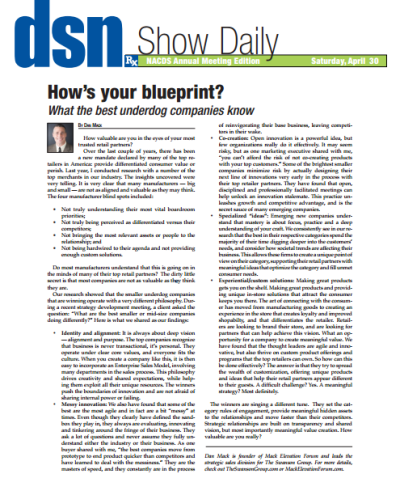How valuable are you in the eyes of your most trusted retail partners?
Over the last couple of years, there has been a new mandate declared by many of the top retailers in America: provide differentiated consumer value or perish. Last year, I conducted research with a number of the top merchants in our industry. The insights uncovered were very telling. It is very clear that many manufacturers — big and small — are not as aligned and valuable as they may think. The four manufacturer blind spots included:
• Not truly understanding their most vital boardroom priorities;
• Not truly being perceived as differentiated versus their competitors;
• Not bringing the most relevant assets or people to the relationship; and
• Not being hardwired to their agenda and not providing enough custom solutions.
Do most manufacturers understand that this is going on in the minds of many of their top retail partners? The dirty little secret is that most companies are not as valuable as they think they are. Our research showed that the smaller underdog companies that are winning operate with a very different philosophy.
During a recent strategy development meeting, a client asked the question: “What are the best smaller or mid-size companies doing differently?” Here is what we shared as our findings:
• Identity and alignment: It is always about deep vision — alignment and purpose. The top companies recognize that business is never transactional, it’s personal. They operate under clear core values, and everyone fits the culture. When you create a company like this, it is then easy to incorporate an Enterprise Sales Model, involving many departments in the sales process. This philosophy drives creativity and shared expectations, while helping them exploit all their unique resources. The winners push the boundaries of innovation and are not afraid of sharing internal power or failing.
• Messy innovation: We also have found that some of the best are the most agile and in fact are a bit “messy” at times. Even though they clearly have defined the sandbox they play in, they always are evaluating, innovating and tinkering around the fringe of their business. They ask a lot of questions and never assume they fully understand either the industry or their business. As one buyer shared with me, “the best companies move from prototype to end product quicker than competitors and have learned to deal with the messiness.” They are the masters of speed, and they constantly are in the process of reinvigorating their base business, leaving competitors in their wake.
• Co-creation: Open innovation is a powerful idea, but few organizations really do it effectively. It may seem risky, but as one marketing executive shared with me, “you can’t afford the risk of not co-creating products with your top customers.” Some of the brightest smaller companies minimize risk by actually designing their next line of innovations very early in the process with their top retailer partners. They have found that open, disciplined and professionally facilitated meetings can help unlock an innovation stalemate. This practice unleashes growth and competitive advantage, and is the secret sauce of many emerging companies. • Specialized “ideas”: Emerging new companies understand that mastery is about focus, practice and a deep understanding of your craft. We consistently see in our research that the best in their respective categories spend the majority of their time digging deeper into the customers’ needs, and consider how societal trends are affecting their business. This allows these firms to create a unique point of view on their category, supporting their retail partners with meaningful ideas that optimize the category and fill unmet consumer needs.
• Experiential/custom solutions: Making great products gets you on the shelf. Making great products and providing unique in-store solutions that attract the consumer keeps you there. The art of connecting with the consumer has moved from manufacturing goods to creating an experience in the store that creates loyalty and improved shopabilty, and that differentiates the retailer. Retailers are looking to brand their store, and are looking for partners that can help achieve this vision. What an opportunity for a company to create meaningful value. We have found that the thought leaders are agile and innovative, but also thrive on custom product offerings and programs that the top retailers can own. So how can this be done effectively? The answer is that they try to spread the wealth of customization, offering unique products and ideas that help their retail partners appear different to their guests. A difficult challenge? Yes. A meaningful strategy? Most definitely.
The winners are singing a different tune. They set the category rules of engagement, provide meaningful hidden assets to the relationships and move faster than their competitors. Strategic relationships are built on transparency and shared vision, but most importantly meaningful value creation.
How valuable are you really?


